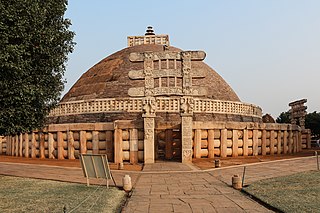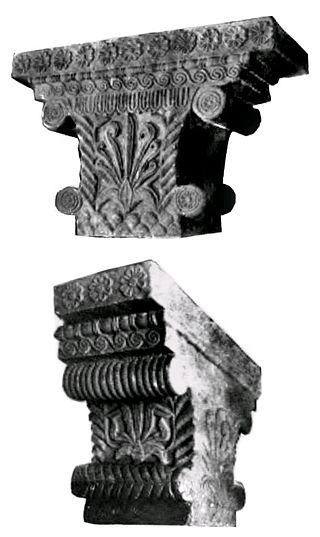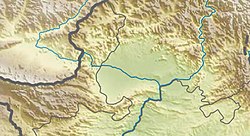
In Buddhism, a stupa is a mound-like or hemispherical structure containing relics that is used as a place of meditation.

Swat District, also known as the Swat Valley, is a district in the Malakand Division of Khyber Pakhtunkhwa, Pakistan. Known for its stunning natural beauty, the district is a popular tourist destination. With a population of 2,687,384 per the 2023 national census, Swat is the 15th-largest district of Khyber Pakhtunkhwa.

The Kanishka casket or Kanishka reliquary, is a Buddhist reliquary made in gilded copper, and dated to the first year of the reign of the Kushan emperor Kanishka, in 127 CE. It is now in the Peshawar Museum in the historic city of Peshawar, Pakistan.
Chakdara (چکدرہ) is a city in the Lower Dir District of Khyber Pakhtunkhwa, Pakistan. It is the second largest city in Dir Lower after Timergara. It serves as a gateway of Malakand Division. It is located in the center of Malakand Division at the entrance of the Lower Dir District, also near the entrance of the Swat District. The Swat Expressway's Chakdara interchange touches this area. Chakdara is about 130 km far from Peshawar, 40km from Mingora and 38 km from Timergara.
The Lower Swat Valley in Swat and Lower Dir Districts in Pakistan is an area of important archeological sites.

Saidū Sharīf is the capital of the Swat district, Khyber Pakhtunkhwa, Pakistan. The city also serves as the capital of the Malakand Division. It was named after Saidu Baba, a prominent leader of the former state of Swat.

Mingora is a city in the Swat District of Khyber Pakhtunkhwa, Pakistan. Located on the Swat River, it is the 3rd largest city in Khyber Pakhtunkhwa and the 26th largest in Pakistan. Mingora is the largest city and the epicenter of social, cultural, and economic activities in Malakand Division, and also the largest in the northern part of Khyber Pakhtunkhwa.

Barikot is a town located in the middle course of the Swat River in Khyber Pakhtunkhwa, Pakistan. It is located about 20 km (12 mi) away from Mingora and the Butkara Stupa. It is the entrance town to the central Swat Valley with a population of approximately 25,000 people. Barikot is the location of an ancient citadel captured by Alexander the Great, with Chalcolithic remains dating back to c. 1700 BCE, and an early-historic period town dating back to c. 600 BCE. The Italian Archaeological Mission founded by Giuseppe Tucci has been excavating ruins of the ancient town of Bazira under Barikot since 1984.

The Butkara Stupa is an important Buddhist stupa near Mingora, in the area of Swat, Pakistan. It may have been built by the Mauryan emperor Ashoka, but it is generally dated slightly later to the 2nd century BCE.
Muhammad Rafiq Mugal is a Pakistani archaeologist, engaged in investigating of ethnoarchaeological research in Chitral, northern Pakistan. He has been responsible for the direction, technical support and supervision for restoration and conservation of more than thirty monuments and excavated remains of the Islamic, Buddhist and Proto-historic periods, in Punjab, Khyber-Pakhtunkhwa and Gilgit-Baltistan of Pakistan. He served as a professor of archaeology and heritage management and the director of undergraduate studies at Boston University. He is now Professor Emeritus of Archaeology at Boston University.

The Dharmarajika Stupa, also referred to as the Great Stupa of Taxila, is a Buddhist stupa near Taxila, Pakistan. It was built over the relics of the Buddha by Ashoka in the 3rd century BCE. The stupa, along with the large monastic complex that later developed around it, forms part of the Ruins of Taxila - which were inscribed as a UNESCO World Heritage Site in 1980.

The sources which are used to reconstruct the history of the Indo-Greeks are few and disparate, leading to much uncertainty about the precise state of the Indo-Greek kingdom and its chronology. Sources related to the Indo-Greeks can be classified into various categories: ancient literary sources from both the West and the Indian world, archaeological sources from the general area of present day Pakistan, Kashmir and North Indian states of Punjab, Haryana, Himachal Pradesh, Uttar Pradesh & Bihar, and numismatical sources, which are abundant and well-preserved but often rather cryptic.

Jaulian is a ruined Buddhist monastery dating from the 2nd century CE, located in Taxila, in Pakistan.

Shalban Bihar is an archaeological site in Moinamoti, Comilla, Bangladesh. The ruins are in the middle of the Lalmai hills ridge, and these are of a 7th-century Paharpur-style Buddhist Bihar with 115 cells for monks. It operated through the 12th century.

Sultan Mahmud Ghaznavi Mosque is one of the oldest mosques in northern Pakistan, discovered by the Italian Archaeological Mission in Pakistan in 1985. The mosque represents a design of old Muslim architecture.
Giovanni Verardi is an Italian archaeologist specialising in the civilisations of central Asia and India. With extensive academic and fieldwork experience, he has published findings about sites in Afghanistan, Nepal, India, and China in particular. Verardi has joined or directed several long archaeological missions to central Asia, and held positions on numerous Italian scientific boards. He has a particular interest in Indian iconography and history.

Swat Museum is a museum located in Mingora, on the road connecting Mingora and Saidu Sharif in the Swat District of the Khyber Pakhtunkhwa province of Pakistan.

Hellenistic influence on Indian art and architecture reflects the artistic and architectural influence of the Greeks on Indian art following the conquests of Alexander the Great, from the end of the 4th century BCE to the first centuries of the common era. The Greeks in effect maintained a political presence at the doorstep, and sometimes within India, down to the 1st century CE with the Greco-Bactrian Kingdom and the Indo-Greek Kingdoms, with many noticeable influences on the arts of the Maurya Empire especially. Hellenistic influence on Indian art was also felt for several more centuries during the period of Greco-Buddhist art.

Nemogram stupa is located 45 km west of Saidu Sharif and 22 km from Birkot, on the right bank of Swat river in Pakistan.This site was discovered in 1966 and excavated in 1967–68. Swat is rich in historical landmarks as well as natural beauty. In every direction, these are tangled in the wide valley. Aurel Stein, a British archaeologist, and Tucci, who was followed by other Italians, worked tirelessly to document and preserve these monuments.
Gumbat Stupa is a 2nd-century Buddhist stupa located in Swat valley in Pakistan. It is situated about 9 kilometres south of Birkot in the Kandag Valley of Gandhara.






















